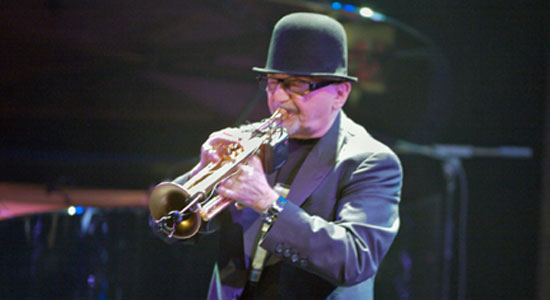It’s the 31st annual Festival International de Jazz de Montréal. MAGNET’s Mitch Myers translates the action.
Canada loves guitars, that much is true. In some ways, the general population up here behaves as if it’s still the 20th century and the guitar remains the instrument of choice. A couple of years ago at a Pat Metheny concert, I even saw someone playing air guitar with serious abandon. Recently, in addition to the annual Jazz Festival, the producers have added the Montreal Guitar Show, showcasing a series of concerts (including world-class players like Charlie Hunter and Sylvain Luc) and a convention hall housing more than 130 amazing guitar luthiers—acoustic and electric—and their wares. I attended a press conference honoring none other than George Benson, who was presented with a lovely tribute award, symbolically made of two different types of wood, one from North America and one from Africa.
In any case, watching guitarist John Scofield and his Piety Street Band perform at the Jazz Fest, I was amused/amazed at the heartfelt devotion to guitars displayed by Montreal fans. In keeping with the festival’s never-ending emphasis on the music of New Orleans, Scofield seemed happy playing soulful old gospel tunes and trotting out copious amounts of electrified blues licks for a full house at the Théâtre Maisonneuve of Place des Arts. Scofield’s Piety project is more than a year old now, but that didn’t seem to bother anyone. The band was nice and tight, with singer/keyboardist John Cleary, drummer Terrence Higgins and famed Meters bassist George Porter Jr.. Sounding like a junior-league Jeff Beck disciple, Scofield played a series of blues, ballads, gospel tunes and old rock ‘n’ roll for his audience. They loved it—me, not so much.
I left before the end of Scofield’s show to run around the corner to the massive Salle Wilfred Pelletier hall for a performance by the Keith Jarrett Trio. Last year, the prickly pianist caused quite a stir as he castigated the Montreal crowd for taking pictures with their cellular phones. This was not an isolated incident, as Jarrett also insulted both the crowd and city at the Umbria Jazz Festival, where he is now not welcome to return. The Montreal programmers were more forgiving than those in Umbria, and as a result, we paid the price. The show was really quite remarkable, with Jarrett, bassist Gary Peacock and drummer Jack DeJohnette playing with telepathic accuracy and spellbinding creativity. The Keith Jarrett Trio is strictly a standards band, and they played beautifully on classic compositions like “Autumn Leaves,” Ornette Coleman’s “When Will The Blues Leave” and “Why Does Everything Happen To Me.” Piano aficionados were oohing and aahing and laughing and cheering as Jarrett dazzled the crowd with his emphatic embellishments and virtuosic displays of pianistic dexterity. Jarrett was clearly feeling it, as he crouched half-standing, head bent low and hands flying across (or gently caressing) the keyboard. One hour flew by like nothing, and after an extended intermission, the band came back and did it again. Then, after the second set and a standing ovation, the band returned to take a bow, and some folks in the audience just had to disregard the emphatic house requests to refrain from taking photos. Jarrett saw camera flashes, got all huffy, reprimanded the crowd once again, took his faithful bandmates and walked off the stage, refusing to return. It’s too bad that this strange recurring confrontation between Jarrett and his audience continues to distract from some truly great performances. But, as they say, that’s showbiz.
As per usual, I went straight to the Gesù Theater for some late-night spiritual healing and some blissed-out shut-eye, this time with Polish trumpeter Tomasz Stańko and his bright young Finnish/Danish band. Stańko is a jazz veteran who began his career playing back in the ’60s. In the course of the following decades, he’s played with a number of jazz greats, lost his teeth and had to completely rework his embouchure. Playing songs off his latest ECM disc, Dark Eyes, Stańko sounded sure and dramatic. It took some time, but he was in total control, thriving on lush ballads as the show progressed. The skilled group showed focus and determination under Stańko’s direction, and the Gesù crowd seemed quite pleased with the results. Later, after the show and back at the hotel, I watched and listened as Stańko entertained his band with stories of his groups in the ’70s, before most of his current band members were even born.
That’s how jazz is, with its elders passing knowledge down to the eager young lions and crusty old journalists telling young readers some of the many things that they should know.
—photo by Michael Jackson







